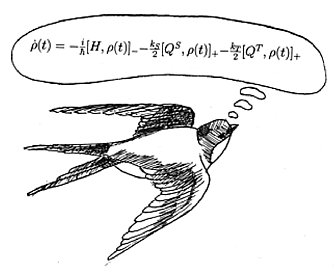  
The introductory figure summarizes our model for a photoreceptor-based
magnetic compass in birds. The geomagnetic field can affect radical-pair
reaction yields as governed by the stochastic Liouville equation depicted
in the thinking bubble of the bird. These effects result in a modulation
of visual information as shown in the right figure. The changes of visual
modulation patterns with different orientations of the bird can explain
the magnetic compass orientation observed in behavioral experiments.
The Physics Problem
In understanding the mechanism of magnetoreception, one is immediately
faced with the puzzle that the geomagnetic field is very weak (ca. 50 microTesla).
Any suggestion for a magnetoreceptor mechanism needs to address the question
whether a field as weak as the geomagnetic field can be detected by the
proposed mechanism under conditions as can be found in animals. Of the
many mechanisms proposed only two have been supported by theoretical analysis
and experimental evidence, namely the use of ferromagnetic material (magnetite)
and the influence of magnetic fields on chemical reactions .
Chemical reactions that involve transitions between different spin states
can be influenced by magnetic fields, so that one of the possible products
is favored due to the influence of the magnetic field. Usually, magnetic
fields much stronger than the geomagnetic field are necessary to see a
significant change in products. For a particular type of chemical reaction,
radical-pair reactions, 50 microTesla (geomagnetic field strength) magnetic
fields produce a small, but measurable change in product ratios. A radical
pair reaction is initiated by absorption of light through a photopigment
and a subsequent electron transfer to a nearby acceptor molecule. After
the electron transfer, donor and acceptor each have one unpaired electron,
which possess a magnetic moment. An external magnetic field can change
the spin state of the radical pair system and thus alter its chemistry.
In other words, the radical pair system acts as a switch that can be triggered
by an external magnetic field.
A Possible Realization
Provided that radical-pair reactions form the basis of magnetoreception
in animals, how could a magnetosensory organ look like? Three components
are necessary: 1. An ordered and fixed system of radical pairs with anisotropic
hyperfine couplings, 2. A photoreceptor that is part of the radical pair
and whose signals to the neural system are modulated through the magnetic
field effects on the radical pairs. 3. A mechanism by which the nervous
system of an animal can identify whether a change in signal is due to an
increase in ambient light levels or due to magnetic field effects.
 In a simple radical-pair
model we have calculated through the use of quantum physics how the response
of a photoreceptor is changed depending on the angle of the magnetic
field lines with the radical-pair system. Assuming that the radical-pair/photoreceptor
system is distributed equally over the whole eye, one can evaluate how
vision of an animal, e.g., a bird, is modulated. To the left, the visual
modulation patterns are shown for a bird flying parallel to the horizon
(geomagnetic field lines at an angle of 68 degrees with the horizon) and
looking towards N,NE,E,SE,S,SW,W, and NW. The patterns are projected into
the plane. In a simple radical-pair
model we have calculated through the use of quantum physics how the response
of a photoreceptor is changed depending on the angle of the magnetic
field lines with the radical-pair system. Assuming that the radical-pair/photoreceptor
system is distributed equally over the whole eye, one can evaluate how
vision of an animal, e.g., a bird, is modulated. To the left, the visual
modulation patterns are shown for a bird flying parallel to the horizon
(geomagnetic field lines at an angle of 68 degrees with the horizon) and
looking towards N,NE,E,SE,S,SW,W, and NW. The patterns are projected into
the plane.
|